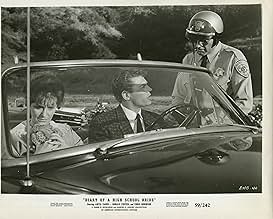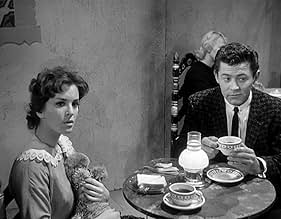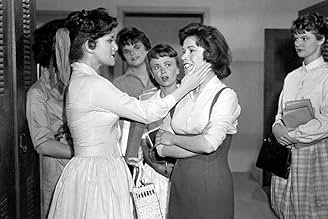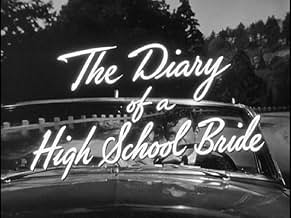Una estudiante de secundaria de 17 años debe justificar su boda con una estudiante de derecho de 24 años ante sus padres y su desequilibrado exnovio.Una estudiante de secundaria de 17 años debe justificar su boda con una estudiante de derecho de 24 años ante sus padres y su desequilibrado exnovio.Una estudiante de secundaria de 17 años debe justificar su boda con una estudiante de derecho de 24 años ante sus padres y su desequilibrado exnovio.
- Dirección
- Guionistas
- Elenco
Ron Foster
- Steve
- (as Ronald Foster)
Frank Biro
- Mr. Lewis
- (as Barney Biro)
Dick Gering
- Richie
- (as Richard Gering)
Elvera Corona
- Dancer
- (as Elvira Corona)
Allan Lurie
- Tony
- (as Al Laurie)
Opiniones destacadas
This 1959 picture starts with a disclaimer stating, "Teenage marriage is one of today's most controversial subjects. The producers do not attempt to present a solution or take sides..."
The producers also take no sides, or seemingly have an issue, with a 24 year old man marrying a 17 year old girl.
Instead, they take the controversial topic and turn it into a pulpy melodrama aimed at the teenage drive-in theatre audience of the times.
Some of the film's elements border on the surreal. Take the beatnik coffee shop that doubles as a flamenco lounge. Or one of the establishment's customers who tunes out the live music, and the world around him, by hearing music from his transistor radio through ear "buds." Or, how about the 17-year old constantly cuddling her stuffed toy dog to symbolize her youth. On her wedding night the camera tilts down from her kissing her husband to her hand dropping the pooch and lingers on her wedding ring.)
Then, there's the psychotic ex-boyfriend. He can't stand that he never got to first base with the now newlywed and resorts to criminal behavior. One could say his actions symbolize the challenges the young couple faces, but, based on director Burt Topper's other work, I doubt the thought ever entered his mind.
The bride is played by Anita Sands who photographs beautifully. Her career, though, was short-lived as she retired from acting at the age of 23 and later became an astrologer to Hollywood stars.
The film is a curiosity for those interested in looking into Hollywood's handling of teen marriage in the 1950s and fans of the work of American International Pictures - the studio that built a mini-empire by focusing on films for young people.
The producers also take no sides, or seemingly have an issue, with a 24 year old man marrying a 17 year old girl.
Instead, they take the controversial topic and turn it into a pulpy melodrama aimed at the teenage drive-in theatre audience of the times.
Some of the film's elements border on the surreal. Take the beatnik coffee shop that doubles as a flamenco lounge. Or one of the establishment's customers who tunes out the live music, and the world around him, by hearing music from his transistor radio through ear "buds." Or, how about the 17-year old constantly cuddling her stuffed toy dog to symbolize her youth. On her wedding night the camera tilts down from her kissing her husband to her hand dropping the pooch and lingers on her wedding ring.)
Then, there's the psychotic ex-boyfriend. He can't stand that he never got to first base with the now newlywed and resorts to criminal behavior. One could say his actions symbolize the challenges the young couple faces, but, based on director Burt Topper's other work, I doubt the thought ever entered his mind.
The bride is played by Anita Sands who photographs beautifully. Her career, though, was short-lived as she retired from acting at the age of 23 and later became an astrologer to Hollywood stars.
The film is a curiosity for those interested in looking into Hollywood's handling of teen marriage in the 1950s and fans of the work of American International Pictures - the studio that built a mini-empire by focusing on films for young people.
The lesson here seems to be that if you are a 17-year-old high school senior who marries a 24-year-old, your parents will be ticked off, your friends will diss you, your ex-boyfriend will get turned on, and your acting career will end up in the toilet. Who saw any of this coming?
Judy (Anita Sands) carries a stuffed animal with her, even on her wedding night. Maybe there is something Freudian in that; I wouldn't know. Her new hubby Steve (Ronald Foster) lives in a one-bedroom apartment, but is a law student, so maybe Judy hopes that someday he will become rich and unprincipled. Chris Robinson, as her borderline psycho ex, is not very menacing, and can be taken out with a few punches. There are several scenes in a teen hangout, a dive which seems to be a combination of fast-food diner, beatnik café, Spanish guitar and dancer mishmash. One of the patrons does something weird with his cheeks, but I didn't rewind to study it more carefully.
Tony Casanova, who apparently had a singing career for a few days (you'll see why if you watch this), performs the title tune, and also another ditty in the hangout. The ending has a modicum of suspense, but by then I doubt if you'll be paying attention. The only bit of interest is a passing reference to "The Screaming Skull," which was far better than this opus - and which is also not saying much. At least that film featured a nice performance by Peggy Webber's upper body.
Judy (Anita Sands) carries a stuffed animal with her, even on her wedding night. Maybe there is something Freudian in that; I wouldn't know. Her new hubby Steve (Ronald Foster) lives in a one-bedroom apartment, but is a law student, so maybe Judy hopes that someday he will become rich and unprincipled. Chris Robinson, as her borderline psycho ex, is not very menacing, and can be taken out with a few punches. There are several scenes in a teen hangout, a dive which seems to be a combination of fast-food diner, beatnik café, Spanish guitar and dancer mishmash. One of the patrons does something weird with his cheeks, but I didn't rewind to study it more carefully.
Tony Casanova, who apparently had a singing career for a few days (you'll see why if you watch this), performs the title tune, and also another ditty in the hangout. The ending has a modicum of suspense, but by then I doubt if you'll be paying attention. The only bit of interest is a passing reference to "The Screaming Skull," which was far better than this opus - and which is also not saying much. At least that film featured a nice performance by Peggy Webber's upper body.
Cute as a button Anita Sands dumps high school beau Chris Robinson to marry law school student Ron Foster. Robinson doesn't take it well. Neither do her parents.
It's not a bad second feature from AIP, which seems to have some opinion that it's not the best idea for boys and girls to drop out of school to get married. Even if it works out, it requires work and maturity, which none of these crazy kids have got. I can't tell whether it's the actors, the script, or directors, but everyone seems a bit shallow and flat here; that may be my age talking. Surely the kids who necked to this in theaters didn't care.
It's not a bad second feature from AIP, which seems to have some opinion that it's not the best idea for boys and girls to drop out of school to get married. Even if it works out, it requires work and maturity, which none of these crazy kids have got. I can't tell whether it's the actors, the script, or directors, but everyone seems a bit shallow and flat here; that may be my age talking. Surely the kids who necked to this in theaters didn't care.
I don't know why, but for some reason "The Diary of a High School Bride" was a title that piqued my curiosity. Unfortunately, the film itself didn't live up to those expectations. I imagined there might be voice-overs of a young high school girl reading from her diary regarding her experiences, memories, feelings, challenges of being, or having been a high school bride. What we're given is something much more straightforward, complete with awkward performances, awkward direction, a weak script, and a story that doesn't really go anywhere and doesn't offer up many genuine insights regarding what it feels like to be a high school bride. Oh sure, there is some information and light shed on this topic, but not as much as it could have. The only interesting thing is the slight bit of suspense towards the very end, which I won't spoil for anyone still interested in checking this film out. Oh, and the painting on the wall referencing another film, "The Screaming Skull", that bit worked well, even if it was only a couple seconds.
Though made for a drive-in audience the movie's not typical of that often tacky fare. A few notes on historical context may help understanding aspects of the film.
Before the big Baby-Boomer Generation, there was the so-called Silent Generation. For obvious reasons, few now have heard of it. For kids coming of age, the period was from about 1950-65, and was called silent because the main ambition of the youngsters was to get married and get a job which were plentiful in that post-WWII era. The popular refrain of the time was "Are we too young to get married". In short, there was little gap between youth and adulthood. One motivating reason was that sex outside of marriage was strictly forbidden. Thus hormonally driven youth were sometimes thrust into early, unhappy marriages. This movie from that era (1959) dramatizes some of the prevailing aspects.
All in all, the movie's best at showing the strains on Steve's and 17-year old Judy's troubled early marriage, especially when she's required to do household drudgery—good touch. In short, being a housewife has a non-romantic downside. Her parents are disapproving of the youthful arrangement as would be expected. But their conniving is fairly subtle. Unfortunately, the movie was produced mainly for teen audiences, so the contrived role of hoodlum Chuck hassling the newly-weds takes up more time than it should, and represents a strictly commercial side. Nonetheless, moments of unexpected quality do pop up, especially in Sands' (Judy) performance dour though it often is. Also, the final shot is more ambiguous than I expected from this type movie. And catch that bang-up look at the intricacies of a movie studio serving as an action climax. For folks interested in modern mores, the film presents some insights, along with a fairly entertaining narrative..
(In passing—Note the semi-Beatnik coffee shop the kids gather at. I say "semi" since something more genuine would have featured jazz, bongo drums, and poetry readings. Whatever the case, the Beatnik fad was short- lived, professing to be a non-conformist movement among the conformist Eisenhower era.)
Before the big Baby-Boomer Generation, there was the so-called Silent Generation. For obvious reasons, few now have heard of it. For kids coming of age, the period was from about 1950-65, and was called silent because the main ambition of the youngsters was to get married and get a job which were plentiful in that post-WWII era. The popular refrain of the time was "Are we too young to get married". In short, there was little gap between youth and adulthood. One motivating reason was that sex outside of marriage was strictly forbidden. Thus hormonally driven youth were sometimes thrust into early, unhappy marriages. This movie from that era (1959) dramatizes some of the prevailing aspects.
All in all, the movie's best at showing the strains on Steve's and 17-year old Judy's troubled early marriage, especially when she's required to do household drudgery—good touch. In short, being a housewife has a non-romantic downside. Her parents are disapproving of the youthful arrangement as would be expected. But their conniving is fairly subtle. Unfortunately, the movie was produced mainly for teen audiences, so the contrived role of hoodlum Chuck hassling the newly-weds takes up more time than it should, and represents a strictly commercial side. Nonetheless, moments of unexpected quality do pop up, especially in Sands' (Judy) performance dour though it often is. Also, the final shot is more ambiguous than I expected from this type movie. And catch that bang-up look at the intricacies of a movie studio serving as an action climax. For folks interested in modern mores, the film presents some insights, along with a fairly entertaining narrative..
(In passing—Note the semi-Beatnik coffee shop the kids gather at. I say "semi" since something more genuine would have featured jazz, bongo drums, and poetry readings. Whatever the case, the Beatnik fad was short- lived, professing to be a non-conformist movement among the conformist Eisenhower era.)
¿Sabías que…?
- TriviaIn January 1960, this film was widely shown in drive-in theaters on a double bill with Ghost of Dragstrip Hollow (1959), also from Alta Vista Productions.
- ErroresSteve and Judy's route home from Las Vegas makes no sense. After they are stopped for speeding, they are shown taking the Balboa ferry--away from the peninsula--in Newport Beach, which is south of Los Angeles. Then they are shown on a freeway in downtown Los Angeles--note the iconic City Hall building in the background.
- ConexionesReferences Hell Squad (1958)
- Bandas sonorasDiary of a High School Bride
Performed and written by Tony Casanova
Selecciones populares
Inicia sesión para calificar y agrega a la lista de videos para obtener recomendaciones personalizadas
Detalles
- Fecha de lanzamiento
- País de origen
- Idioma
- Locaciones de filmación
- Fern Dell, Griffith Park - 4730 Crystal Springs Drive, Los Ángeles, California, Estados Unidos(Judy and Steve go for a walk in a park with footbridges and a small waterfall)
- Productora
- Ver más créditos de la compañía en IMDbPro
Taquilla
- Presupuesto
- USD 80,000 (estimado)
- Tiempo de ejecución1 hora 12 minutos
- Color
- Mezcla de sonido
- Relación de aspecto
- 1.37 : 1
Contribuir a esta página
Sugiere una edición o agrega el contenido que falta

Principales brechas de datos
By what name was The Diary of a High School Bride (1959) officially released in Canada in English?
Responda
























